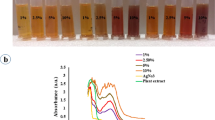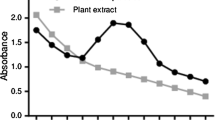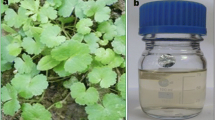Abstract
The use of traditional plants has been tremendously increased due to their higher biological impact, minimal side effects, and comparatively low cost. Moreover, the emergence of antibacterial resistance is also shifting the scientific community to reconsider herbal remedies which provide relatively safer, cheap and biologically tolerable solutions. The present research was designed to fabricate the Mentha spicata conjugated silver nanoparticles (Me-AgNPs). Furthermore, the assessment of the bactericidal potential of Me-AgNPs against various bacterial strains was another motive behind this study. Fabricated NPs were characterized with the help of the UV-Visible spectrophotometric analysis, Fourier transform infrared spectroscopy (FTIR) and Scanning electron microscopy (SEM). Me-AgNPs showed a significant zone of inhibition (23 ± 0.2 mm) at 8 mg/mL against Staphylococcus aureus and a 4.0 ± 0.2 mm zone of growth inhibition at 2 mg/mL against Aeromonas veronii. The stability of Me-AgNPs was assessed at various pH (4, 7 and 11) and temperatures (25 °C, 4 °C, 37 °C, 75 °C). The significant zones of inhibition (11.3 ± 0.3 mm, 8.3 ± 0.3mm, 14.3 ± 0.3 mm, and 7.6 ± 0.2 mm) were observed at pH 11 against Escherichia coli, Staphylococcus aureus, Bacillus subtilis, and Klebsiella pneumoniae, respectively. Growth inhibition zones (14.0 ± 0.5 mm and 13.0 ± 0.5 mm) were also determined against B. subtilis and S. aureus at 25 °C. DPPH bioassay was conducted to find the antioxidant properties of Me-AgNPs. The highest (38.66 ± 0.2%) free radical scavenging activity was shown by Me-AgNPs at 4 mg/mL. Present study results concluded that biogenic Me-AgNPs have bactericidal as well as anti-oxidative potential. Moreover, these green synthesized Me-AgNPs could maintain their potency and stability at a wide range of pH and temperature.
Graphical Abstract

















Similar content being viewed by others
Availability of data and material
All the appropriate data and material regarding the current study is present within the manuscript.
References
Rout GK, Shin HS, Gouda S, Sahoo S, Das G, Fraceto LF, Patra JK (2018) Current advances in nanocarriers for biomedical research and their applications. Art Cells Nanomed Biotechnol 46:1053–1062
Wei S, Li A, Liu C, Li Z, Chen W, Gong Y, Li Y (2018) Direct observation of noble metal nanoparticles transforming to thermally stable single atoms. Nat Nanotechnol 13:856–861
Zhu L, Yang Y, Wang C (2018) Molecular Self‐Assembly for Nanobiomaterial Fabrication. Nanobiomater Classific Fabric Biomed Appl 107–141
Chaudhry Q, Watkins R, Castle L (2017) Nanotechnologies in food: What, why and how? Nanotechnol Food 2:1–19
Saravanan A, Kumar S, Karishma Vo N, Jeevanantham S, Yaashikaa R, George S (2021) A review on biosynthesis of metal nanoparticles and its environmental applications. Chemosphere 264:128580
Tang S, Zheng J (2018) Antibacterial activity of silver nanoparticles: structural effects. Adv Healthc Mater 7:1701503
Dakal C, Kumar A, Majumdar S, Yadav V (2016) Mechanistic basis of antimicrobial actions of silver nanoparticles. Front Microbiol 7:1831
Haaber J, Penadés R, Ingmer H (2017) Transfer of antibiotic resistance in Staphylococcus aureus. Trends Microbiol 25:893–905
Salleh A, Naomi R, Utami D, Mohammad W, Mahmoudi E, Mustafa N, Fauzi B (2020) The potential of silver nanoparticles for antiviral and antibacterial applications: A mechanism of action. Nanomaterials 10(8):1566
Willyard C (2017) Drug-resistant bacteria ranked. Nature 543(7643):15
Lesho P, Laguio-Vila M (2019) The slow-motion catastrophe of antimicrobial resistance and practical interventions for all prescribers. Mayo Clin Proc 94:1040–1047
Mancuso G, Midiri A, Gerace E, Biondo C (2021) Bacterial antibiotic resistance: the most critical pathogens. Pathogens 10:1310
Serra-Burriel M, Keys M, Campillo-Artero C, Agodi A, Barchitta M, Gikas A, Lopez-Casasnovas G (2020) Impact of multi-drug resistant bacteria on economic and clinical outcomes of healthcare-associated infections in adults: Systematic review and meta-analysis. PloS One 15:e0227139
Mangoni L, McDermott M, Zasloff M (2016) Antimicrobial peptides and wound healing: biological and therapeutic considerations. Exp Dermatol 25:167–173
Nuri R, Shprung T, Shai Y (2015) Defensive remodeling: How bacterial surface properties and biofilm formation promote resistance to antimicrobial peptides. Biochim Biophys Acta Biomembr BBA-Biomembranes 1848:3089–3100
Mahlapuu M, Håkansson J, Ringstad L, BjörnC (2016) Antimicrobial peptides: an emerging category of therapeutic agents. Front Cell Infect Microbiol 6:194
Chin W, Zhong G, Pu Q, Yang C, Lou W, De Sessions PF, Periaswamy B (2018) A macromolecular approach to eradicate multidrug resistant bacterial infections while mitigating drug resistance onset. Nat Commun 9:1–14
Yousefbeyk F, Dabirian S, Ghanbarzadeh S, EghbaliKoohi D, Yazdizadeh P, Ghasemi S (2022) Green synthesis of silver nanoparticles from Stachysbyzantina K. Koch: characterization, antioxidant, antibacterial, and cytotoxic activity. Part Sci Technol 40:219–232
Siddiqi S, Rashid M, Rahman A, Husen A, Rehman S (2018) Biogenic fabrication and characterization of silver nanoparticles using aqueous-ethanolic extract of lichen (Usnealongissima) and their antimicrobial activity. Biomater Res 22:1–9
Biswas K, Mohanta K, Kumar B, Hashem A, Abd_Allah F, Mohanta D, Mohanta, K (2020) Nutritional assessment study and role of green silver nanoparticles in shelf-life of coconut endosperm to develop as functional food. Saudi J Biol Sci 27:1280–1288
Lang C, Mission G, Fuaad A, Shaalan M (2021) Nanoparticle tools to improve and advance precision practices in the Agrifoods Sector towards sustainability-A review. J Clean Prod 293
Vandana B, Kulkarni P, Tanwar S, Kiran S, Kaur G, Kumari Y, Sachdeva K (2021) A Review of reducing agents in chemical and natural synthesis of metallic nanoparticles. Nanosci Nanotechnol-Asia 11:25–36
Fristiohady A, Asasutjarit R, Theeramunkong S, Al-Ramadan W, Haruna LA, Rahmatika NS, Sahidin I (2022) Phytochemical profile and anticancer activity from medicinal plants against melanoma skin cancer: a review. Indonesian J Sci Technol 7(3):405–470
Santhoshkumar J, Kumar V, Rajeshkumar S (2017) Synthesis of zinc oxide nanoparticles using plant leaf extract against urinary tract infection pathogen. Resour Effic Technol 3(4):459–465
Anandan M, Poorani G, Boomi P, Varunkumar K, Anand K, Chuturgoon A, Prabu H (2019) Green synthesis of anisotropic silver nanoparticles from the aqueous leaf extract of Dodonaeaviscosa with their antibacterial & anticancer activities. Process Biochem 80:80–88
Keshari K, Srivastava R, Singh P, Yadav B, Nath G (2020) Antioxidant and antibacterial activity of silver nanoparticles synthesized by Cestrum nocturnum. J Ayurveda Integr Med 11:37–44
Ahmad B, Shireen F, Rauf A, Shariati A, Bashir S, Patel S, Zhang H (2021) Phyto-fabrication, purification, characterisation, optimisation, & biological competence of nano-silver. IET Nanobiotechnology 15:1–18
Shireen F, Ahmad B, Ahmad L, Khan A, Rauf A, Khalil AA, Sharifi-Rad J (2022) Antineoplastic and Cytotoxic Evaluation of Green AgNPs and Crude Extracts from Agave americana, Mentha spicata, and Mangiferaindica Leaves. J Nanomater
Awda M (2019) Biosynthesis of silver nanoparticles using mints leaf extract and evaluation of their antimicrobial activity. Biochem Cell Arch 19:2903–2908
Gabriela M, Luis M, Reinaldo R, Michael M, Rodolfo P, Roberto J (2017) Biosynthesis of silver nanoparticles using mint leaf extract (Menthapiperita) and their antibacterial activity. Adva Sci Eng Med 9:914–923
Muhammad Tahir H, Saleem F, Ali S, Ain QU, Fazal A, Summer M, Murtaza G (2020). Synthesis of sericin‐conjugated silver nanoparticles and their potential antimicrobial activity. J Basic Microbiol 60(5):458–467. https://doi.org/10.1002/jobm.201900567
Mumtaz S, Ali S, Kazmi SAR, Mughal TA, Mumtaz S, Tahir HM, Rashid MI (2023) Analysis of the antimicrobial potential of sericin‐coated silver nanoparticles against human pathogens. Microsc Res Tech 86(3):320–330. https://doi.org/10.1002/jemt.24273
Summer M, Tahir HM, Ali S, Abaidullah R, Mumtaz S, Nawaz S (2023) Bactericidal potential of different size sericin-capped silver nanoparticles synthesized by heat, light, and sonication. J Basic Microbiol. https://doi.org/10.1002/jobm.202200632
Jurić T, Mićić N, Potkonjak A, Milanov D, Dodić J, Trivunović Z, Popović BM (2021) The evaluation of phenolic content, in vitro antioxidant and antibacterial activity of Mentha piperita extracts obtained by natural deep eutectic solvents. Food Chem 362
Silva WMF, Bona NP, Pedra NS, Cunha KD, Fiorentini AM, Stefanello FM, Dias ARG (2022) Risk assessment of in vitro cytotoxicity, antioxidant and antimicrobial activities of Mentha piperita L. essential oil. J Toxicol Environ Health Part A 85(6):230–242
Ambrożej K, Martyna A, Karpińska J, Dadasiewicz K, Sikorska A (2021) Quality control of mint species based on UV-VIS and FTIR spectral data supported by chemometric tools. Food Control 129:108228
Nouri A, Yaraki MT, Lajevardi A, Rezaei Z, Ghorbanpour M, Tanzifi M (2020) Ultrasonic-assisted green synthesis of silver nanoparticles using Mentha aquatica leaf extract for enhanced antibacterial properties and catalytic activity. Colloid Interface Sci Commun 35
Gholami M, Azarbani F, Hadi F, Murthy HA (2022) Eco-friendly synthesis of copper nanoparticles using Mentha pulegium leaf extract: characterisation, antibacterial and cytotoxic activities. MaterTechnol 37(10):1523–1531
Alsamhary K (2020) Eco-friendly synthesis of silver nanoparticles by Bacillus subtilis and their antibacterial activity. Saudi J Biol Sci 27:2185–2191
Niska K, Knap N, Kędzia A, Jaskiewicz M, Kamysz W, Inkielewicz-Stepniak I (2016) Capping agent-dependent toxicity and antimicrobial activity of silver nanoparticles: an in vitro study. Concerns about potential application in dental practice. Int J Med Sci 13(10):772
Guilger-Casagrande M, Germano-Costa T, Bilesky-José N, Pasquoto-Stigliani T, Carvalho L, Fraceto LF, de Lima R (2021) Influence of the capping of biogenic silver nanoparticles on their toxicity and mechanism of action towards Sclerotinia sclerotiorum. J Nanobiotechnol 19:1–18
Kapp K, Orav A, Roasto M, Raal A, Püssa T, Vuorela H, Vuorela P (2020) Composition and antibacterial effect of MINT flavorings in candies and food supplements. PlantaMedica 86:1089–1096
Brown N, John A, Shahid F (2019) Polyphenol composition & antioxidant potential of mint leaves. Food Prod Process Nutr 1:1–14
Moosavy MH, de la Guardia M, Mokhtarzadeh A, Khatibi SA, Hosseinzadeh N, Hajipour N (2023) Green synthesis, characterization, and biological evaluation of gold and silver nanoparticles using Mentha spicata essential oil. Sci Rep 13(1):7230
Wang W, Ma P, Zhao Q, Goorani S (2022) Beneficial properties of the biosynthesized silver/chitosan nanoparticles mediated by Mentha piperita in rats with heart failure following myocardial infarction. Inorg Chem Commun 141
Bashir I, Khan MA, Dilshad E, Siyo B, Hussain E, Ali I (2021) Antioxidant and anticancer silver nanoparticles of Mentha asiatica aerial part extract: a novel study. Inorg Nano-Metal Chemy 1–7
Rauf A, Ahmad T, Khan A, Maryam Uddin G, Ahmad B, Al-Harrasi A (2021) Green synthesis and biomedicinal applications of silver and gold nanoparticles functionalized with methanolic extract of Mentha longifolia. Artif Cells Nanomed Biotechnol 49(1):194–203
Javed B (2020) Synergistic effects of physicochemical parameters on bio-fabrication of mint silver nanoparticles: structural evaluation and action against HCT116 colon cancer cells. Int J Nanomed 15:3621
Funding
Current study was not funded by anybody/organization.
Author information
Authors and Affiliations
Contributions
T. T. performed the experiment and wrote the manuscript. S.A. supervised the experiment and edited the manuscript. N. M. A. supervised the experiment and edited the manuscript. M.A.F. edited the manuscript. M.S. edited the manuscript and characterization analysis. A. H. assisted in writeup and reference management. F. A. performed the experiment and wrote the manuscript. M. I. edited the manuscript. L. K. edited the manuscript. H. S. performed the experiment. R. I. managed the references.
Corresponding author
Ethics declarations
Ethical Approval
As no animal is being used/sacrificed in present study, ethical approval was not applicable.
Conflict of Interest
There is no conflict of interest of author regarding the present study.
Additional information
Publisher's Note
Springer Nature remains neutral with regard to jurisdictional claims in published maps and institutional affiliations.
Research Highlights
• Novel, eco-friendly and cost-effective Mentha spicata-conjugated silver nanoparticles were synthesized.
• Fabricated NPs were characterized with the help of the UV-Visible spectrophotometric analysis, Fourier transform infrared spectroscopy and Scanning electron microscopy.
• The stability of Mentha spicata-conjugated silver nanoparticles synthesized at various temperature and pH values was analyzed.
• The Mentha spicata conjugated silver nanoparticles were found effective against various bacterial pathogens.
Rights and permissions
Springer Nature or its licensor (e.g. a society or other partner) holds exclusive rights to this article under a publishing agreement with the author(s) or other rightsholder(s); author self-archiving of the accepted manuscript version of this article is solely governed by the terms of such publishing agreement and applicable law.
About this article
Cite this article
Tanveer, T., Ali, S., Ali, N.M. et al. Evaluating the Effect of pH, Temperature and Concentration on Antioxidant and Antibacterial Potential of Spectroscopically, Spectrophotometrically and Microscopically Characterized Mentha Spicata Capped Silver Nanoparticles. J Fluoresc 34, 1253–1267 (2024). https://doi.org/10.1007/s10895-023-03322-z
Received:
Accepted:
Published:
Issue Date:
DOI: https://doi.org/10.1007/s10895-023-03322-z




